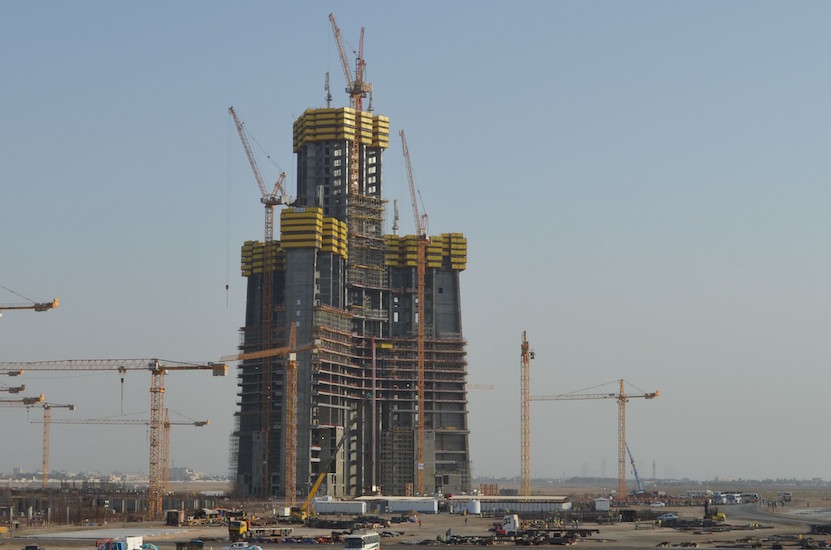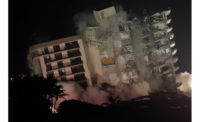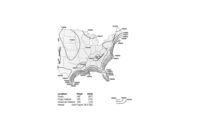Structural and Geotechnical Engineers Call for Collaboration
Enhanced Communication Would Benefit the Built Environment, They Say

Geotechnical and structural designers for the Jeddah Tower had to work through more than two dozen iterations before they aligned the design of the foundations with the design of the 1-kilometer-plus superstructure.
Photo Courtesy of Jeddah Economic Co.
From buildings to bridges, the built environment would benefit from a stronger collaboration between structural engineers and geotechnical engineers, leaders of both disciplines agree. But barriers to teamwork abound in the form of business practices, contracting norms, fee structures and professional rivalries, said engineers at the first joint conference of the two disciplines, organized by the 12,742-member Geo-Institute and the 31,000-member Structural Engineering Institute of the American Society of Civil Engineers.
“Better collaboration would lead to better projects, which would lead to better public health, safety and welfare,” said Jim Rossberg, ASCE’s managing director of engineering programs, at the Geotechnical & Structural Engineering Congress, held Feb. 14-17, in Phoenix.
“We want to be brought to the table early and be involved throughout the project,” said Kord Wissmann, president of the Geo-Institute.
On many projects, structural and geotech engineers work at cross purposes, agreed the experts. Geotechs are conservative in issuing soil capacities for building and foundation loads, in part due to inconsistent and unknown subsurface conditions. Structurals are trying to produce efficient structures to save space, construction time and material costs.
The structural engineer is focused on meeting prescriptive design codes and standards, while the geotechnical engineer is focused on standards for test piles.
Both disciplines hedge risks, agreed the experts. Geotechs hedge risk by building in a great deal of uncertainty into their report recommendations, and structurals hedge their risk by building in a great deal of finality into their drawings.
Some engineers at the conference, which attracted 1,952 attendees, called for changing current practice and opening up direct lines of communication between the disciplines. Current practice is a “project delivery flaw,” said Wissmann, president of Geopier Foundation Co. To change practice, engineers must “properly describe the value of collaboration to owners.”
In part, confusion is widespread because there are no standard roles on a project. Often the owner hires the geotech engineer before schematic design or earlier. The structural engineer—more typically contracted to the architect—is not always engaged as early as the others.
There are other contract models. On civil-works projects, it’s common for the structural engineer, as prime consultant, to hire the geotech. In that case, Murphy advises structurals to use the Council of American Structural Engineers Tool 6-2: Scope of Work for Engaging Subconsultants, available from the American Council of Engineering Companies.
For the geotech to do its job well, information from the structural engineer is important—and the earlier, the better, said Michael S. Ulmer, a senior engineer with geotech S&ME Inc. Though structural loads and differential settlements are primary, Ulmer wants more detail, including the location of anticipated loads, grading plans and more.
Contracts aside, best practice is to call the structural engineer early on, “introduce yourself and say, ‘Let’s work together,’ ” said Ulmer.
On one megaproject—Saudi Arabia’s Jeddah Tower, formerly known as the Kingdom Tower—the geotech designer Langan and the structural designer Thornton Tomasetti communicated throughout the design phase. The teams went through more than two-dozen computer-modeling iterations before they aligned TT's superstructure design for the planned 1-kilometer-plus residential tower with Langan's foundation design.
TT and Langan had to agree on differential settlements for a gravity load of 860,000 tonnes for the primarily reinforced-concrete bearing-wall structure, according to Robert Sinn, a TT principal. The tower's core is currently at level 36; wing walls trail at 24.
Engineers are not taking issue with megaprojects. Rather, it’s the two- to five-story projects, said Wissmann. There is more trouble on simpler projects because “all parties are scared on complicated jobs,” added Michael Murphy, a structural engineer with M2. That means they pay more attention and talk to each other more.
Nevertheless, at the conference, Alan R. Poeppel, the Langan senior vice president who led the Jeddah Tower project, offered advice to fellow geotechs, saying, “Listen to your structural engineers. Sometimes they are smarter than you think.”
This article was updated on March 14, 2016.







